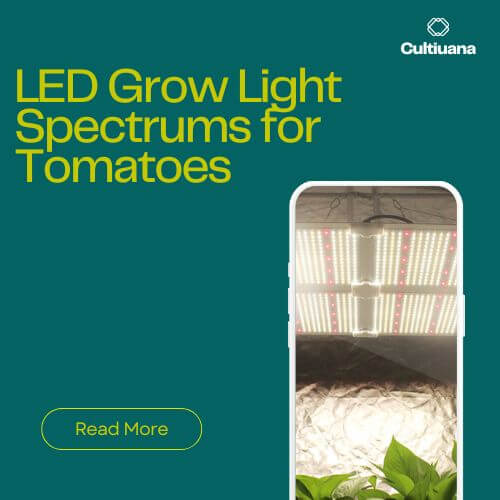
Convert HID Grow Lights to LED
We’ve been getting a lot of messages from you all about changing over to LED lights for your plants. You’re asking, “What do I need to do differently to make LED lights work well?”
Here’s a quick tip: Remember that enzyme in plants, RuBisCO, we talked about before? When you switch from HID to LED lights, you should turn up the heat a little.
LEDs don’t make things as warm as HIDs do, and plants need to be warm enough to grow properly. Try bumping up the temperature in your growing space by about 3-6 degrees Fahrenheit (that’s 2-4 degrees Celsius) higher than what you did with HIDs, then see how it goes and adjust if you need to.
Again, about RuBisCO: RuBisCO is like a tiny worker in plant leaves that helps turn air and energy from the sun into food for the plant.
It’s super important because it’s the first step in making all the stuff plants need to grow. But this little guy works best at certain temperatures, so if it’s too cold, it won’t work as fast, and your plants won’t grow as quick.
That’s why you want to keep your plants nice and warm, especially when using LEDs.
HID Grow Lights VS LED Comparison Table
| Feature | HID | LED |
|---|---|---|
| Energy Efficiency | Low | High |
| Durability | Fragile - has moving parts, glass bulbs, and filaments | Heavy-duty, has no electrode or filament, shock & vibration resistant |
| Lifetime | 10,000 to 25,000 hours | 100,000 hours |
| Lumen Depreciation | Moderately high | Low |
| Operating Temperature | -30° to 65°C | -55° to 70°C |
| Performance | Requires 5-10 minute warm-up time, creates light in all directions | Turns on instantly, no flickering, creates focused light |
| Color Quality | Average | Superior |
| Light Pollution | High | No |
| Dimmable/controllable | No | Yes |
| Cost | Lower upfront cost, but requires regular relamping and ballast replacement | Higher upfront cost but virtually no maintenance expenses |
A/C Performance: LED VS. HID
When it comes to cooling your grow room, LED and HID lights act very differently. HID lights get hot really fast because they work by making a gas so hot it shines bright.
They can reach their top heat in just about 10 to 15 minutes, which doesn’t give your air conditioner (A/C) much time to kick in and cool things down. It’s like the A/C is always playing catch-up with the heat, which can be tough on it and might even shorten its life.
LEDs, on the other hand, take their time to warm up, usually around 30 to 60 minutes. This chill pace is much easier for the A/C to handle because it can start cooling down the air as the heat slowly builds up, just like it’s meant to do.
If you look at the charts we’ve got, you’ll see that with HID lights, the A/C has to work harder and deal with a bigger difference between the hot and cool temperatures it’s trying to manage.

Changes in Dehumidification Strategy
Like we talked about before, plants are like sponges; they suck up water and then let out about 97% of it back into the air. If you have a big plant, say over 5 feet tall, that’s a lot of water getting into the air.
And when you water your plants by hand or mist them, you’re adding even more moisture, which can really make things humid, especially if you’ve got a big room with thousands of plants.
A lot of growers use their air conditioning (A/C) to help keep the moisture levels down. This might be okay when you’re using those hot HID lights because they make the A/C work harder, pulling out moisture along the way.
But if you switch to LED lights, especially in colder months, you might hit a snag. You see, LEDs don’t need the room to be as hot, which means the A/C won’t run as much, and that means it won’t pull out as much water from the air.
Sure, warmer air can hold more water, but it’s often not enough to make up for the difference.
If you’re thinking of switching your grow room from HIDs to LEDs, you’re probably going to need to beef up your dehumidifying game. We’ve seen LED rooms that needed double the dehumidification than rooms with HIDs.
It’s a good idea to get help from a grow expert and an HVAC pro who knows their stuff about plants when you make the switch. They can help you get the humidity just right from the get-go.
When LED grow lights first hit the market, everyone wanted to see how they stacked up against the old-school HID lights in a direct face-off. People were like, “Let’s see if they really work!”.
But here’s the thing: these trials could be set up to make one or the other look better, all based on the room temperature.
Let’s say you want HID lights to come out on top: just drop the temperature of the room. HID lights give off a lot of heat, which can keep them toasty, while the LED-grown plants might get too cold and not grow as much.
On the flip side, if you’re rooting for LEDs, crank up the heat. The plants under the HID lights might get too hot, which could mess with their growth and quality, but the LEDs will be just fine.
Besides just the temperature, there’s also the chance that light from the HID side might spill over and boost the LED side’s results, because HID lights aren’t great at only hitting their target area and can accidentally “leak” light.
That’s another reason why these head-to-head trials might not give us the real scoop on which light is better.





